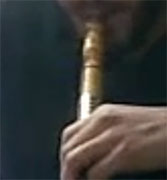- Skip Storing This Everyday Product in the Fridge Door
- Green Tea + B3 Pairing May Boost Brain Health
- Navigating Your Midlife Crisis: Embracing New Possibilities
- City Raccoons Showing Signs of Domestication
- Mapping the Exposome: Science Broadens Focus to Environmental Disease Triggers
- One Week Less on Social Media Linked to Better Mental Health
- Your Brain Changes in Stages as You Age, Study Finds
- Some Suicide Victims Show No Typical Warning Signs, Study Finds
- ByHeart Formula Faces Lawsuits After Babies Sickened With Botulism
- Switch to Vegan Diet Could Cut Your Greenhouse Gas Emissions in Half
Hookah Smoking Popular Among Well-Heeled Teens: Survey


While American teenagers have increasingly been saying “no” to cigarettes over the past decade, almost one in five high school seniors now say they have smoked a hookah pipe, a new survey shows.
A form of smoking that has been a fixture throughout the Middle East and South Asia for centuries, the hookah pipe, with its relatively exotic mechanics, has become trendy among kids who are relatively well-off, the researchers report.
“I actually didn’t find the results very surprising,” noted study author Joseph Palamar, an assistant professor in the department of population health at NYU Langone Medical Center and the NYU Center for Drug Use and HIV Research in New York City. “Cigarette use has decreased so much in recent years. We should have expected another drug or form of the drug to pop up in place of cigarettes.”
“But what we find most interesting is that students of higher socioeconomic status appear to be more likely to use hookah,” Palamar added. “Specifically, students with more educated parents or higher personal income are at high risk for use.”
Palamar and his colleagues report their findings online July 7 in the journal Pediatrics.
To get a snapshot of current hookah use among American teens, the study authors sifted through the results of a poll that was conducted from 2010 to 2012 among more than 5,500 high school seniors who were enrolled at 130 different high schools across the country.
Participants were about equally divided between boys and girls, and more than 60 percent were white. About 45 percent were under the age of 18, while nearly 55 percent were 18 or older.
About 18 percent of the teens said they had used hookahs in the past year.
But while hookah use was just 14 percent among those whose weekly job brought in $10 or less, that figure rose to nearly 23 percent among those whose weekly earnings topped $51 or more.
Hookah use was also found to be slightly higher among teens from relatively well-educated families, as well as among boys, whites and those living in cities.
Teens who smoked cigarettes (or used to) also were more likely to have tried hookahs, as were those who drank alcohol or used illicit drugs.
The investigators noted that hookah smoking often requires that users pay to enter a “hookah bar,” a financial barrier that might explain its greater popularity among those with more disposable income.
That said, the team stressed that the larger concerns are twofold: that hookah smoking is often mistakenly perceived as safer and less addictive than cigarettes, and that hookah use may ultimately serve as a “gateway” to cigarette smoking.
“What I find risky about hookah,” said Palamar, “is [the] perception of it being safer than cigarettes.”
“More research is needed, but right now it appears that a lot of hookah use is more ritualistic. A lot of users appear to use only occasionally with friends, for example, in hookah bars. And not everyone inhales,” Palamar noted. “Cigarette use tends to be much different. For example, we generally don’t have employees stepping out of work to take quick hookah breaks.”
But Palamar stressed that, regardless, “adolescents need to be educated about the potential harms associated with [hookah] use, so they will be able to make informed decisions about use.”
Dr. Norman Edelman, a senior medical consultant for the American Lung Association and a professor of medicine at the State University of New York at Stony Brook, said the bottom line is that “hookah smoking is not safe.”
“It is dangerous,” he noted. “The big myth is that because the smoke bubbles up through water it’s somehow purified and safe. But lots and lots of studies have shown that the smoke users inhale contain all the toxic compounds that are inhaled smoking a cigarette. And the other thing is that when people smoke they often do it for a long time, for like an hour or so. So they get a lot of it. And that means that just one session with a hookah appears to be equivalent to smoking a whole pack of cigarettes.”
“So it’s not surprising that this is becoming more popular among urban kids who have the money for this and are looking for new ways to get a thrill or act out,” Edelman added. “But it’s a popularity based on delusion.”
More information
Visit the U.S. Centers for Disease Control and Prevention for more on hookah smoking.
Source: HealthDay
Copyright © 2025 HealthDay. All rights reserved.










